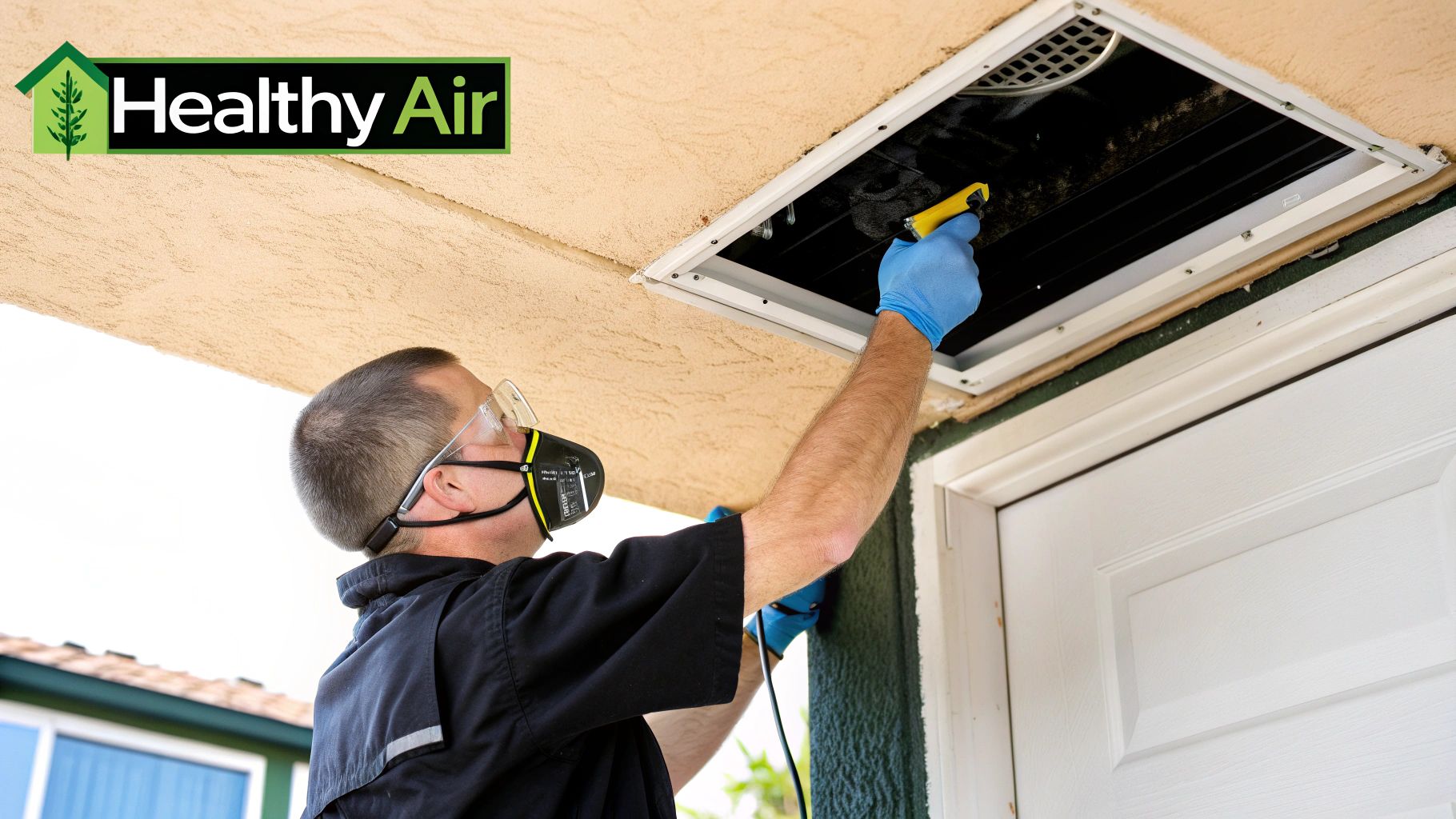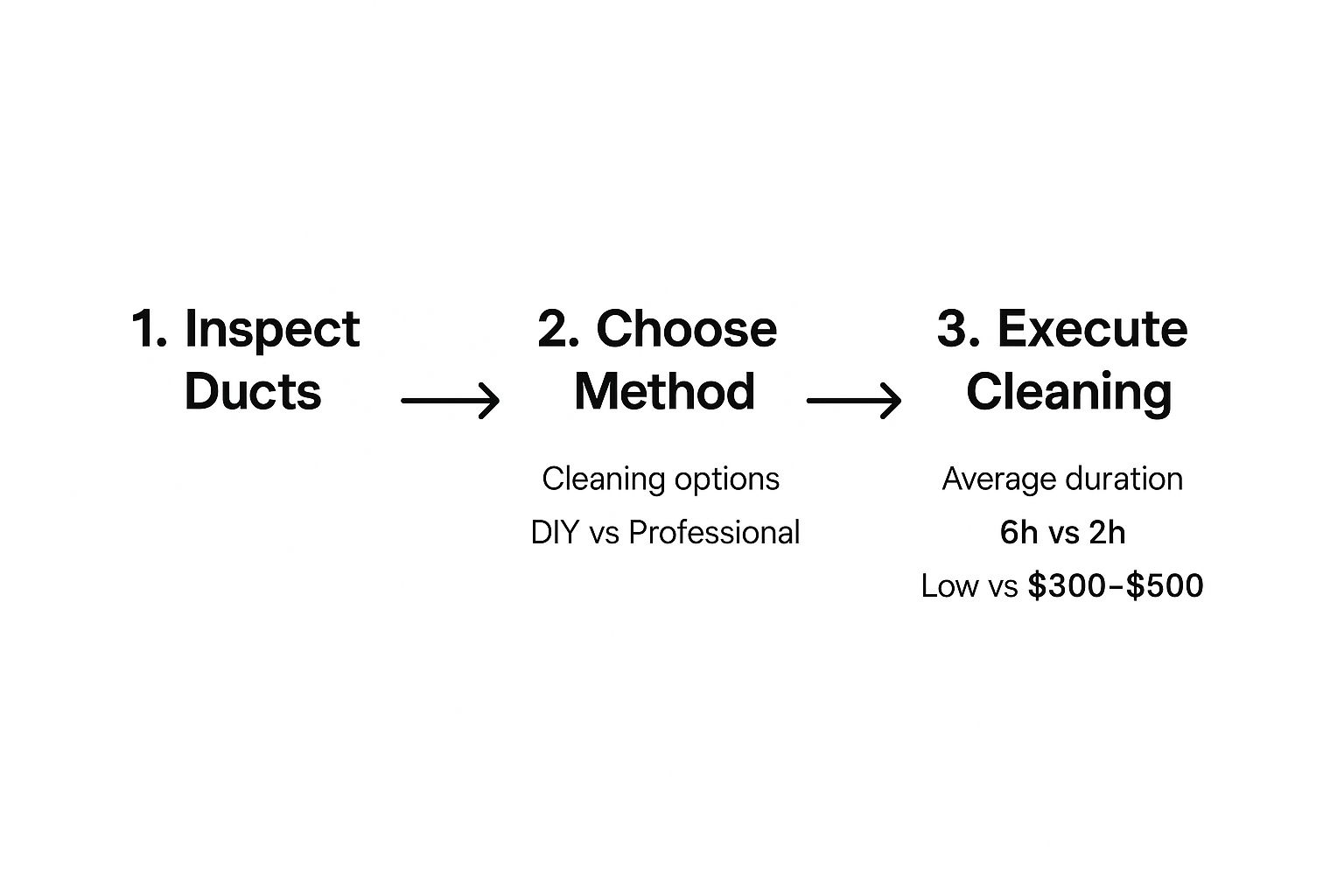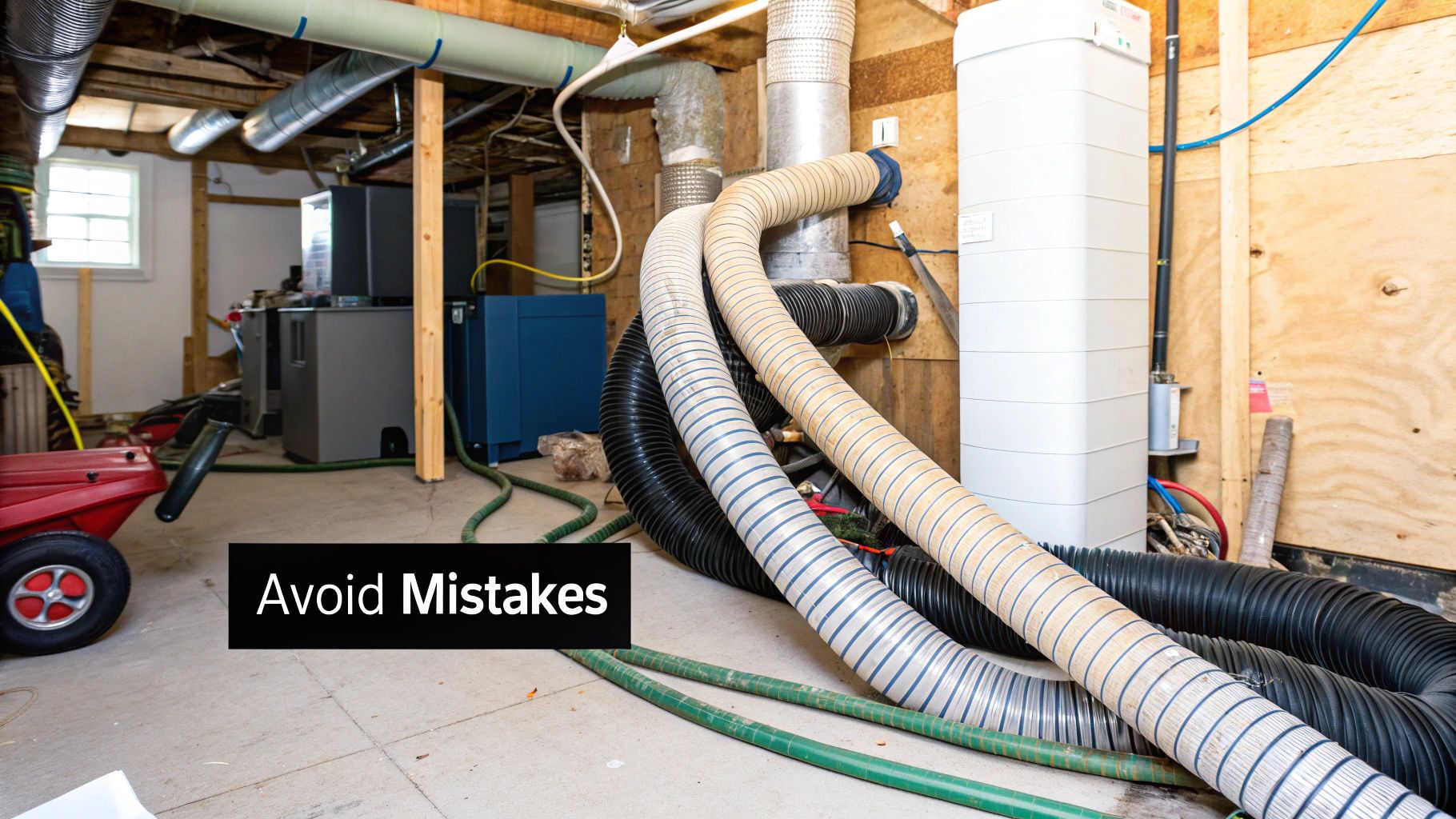Air Duct Cleaning Sanitizing Guide for Homeowners
- shawnpurifiedair
- Jun 28
- 10 min read
When we talk about air duct cleaning and sanitizing, it's really a two-part job. First, you have to get all the physical gunk out—the dust, the debris, you name it. Then, you follow up with an agent designed to knock out the microscopic stuff like bacteria and mold. This combination does more than just a standard cleaning; it’s about drastically improving your home's indoor air quality and getting rid of those stubborn, lingering odors for good.
Why Air Duct Sanitizing Matters for Your Home

Most of us are pretty good at cleaning what we can see. But the real problem often lurks in the hidden network of ductwork that snakes through our homes, pushing air into every room. A standard cleaning is great for removing that visible layer of dust, but it doesn't touch the microscopic organisms that can really flourish in those dark, quiet spaces.
Here’s a good way to think about it: cleaning your ducts is like sweeping the floors. Sanitizing is like mopping with a disinfectant. One gets the loose dirt, but the other kills the germs you can't even see. For any home, but especially for those with pets, allergy sufferers, or a persistent musty smell, air duct cleaning sanitizing isn't just a nice-to-have. It's a key step for a truly healthy home.
Going Beyond a Surface-Level Clean
The main reason to sanitize is to get rid of contaminants that can mess with your respiratory health. These are the unseen culprits that cause ongoing issues that a simple dusting just can’t fix.
The sanitizing process specifically targets:
Microbial Growth: It neutralizes bacteria and fungi that might be growing in damp or dirty ductwork.
Mold Spores: This is a big one. It kills active mold spores, stopping them from circulating and setting up shop elsewhere in your home.
Viruses and Odor-Causing Bacteria: It eliminates the microorganisms behind funky smells and can even help reduce the circulation of sickness-causing germs.
Allergens: The process helps break down common irritants from dust mites and pet dander that set off allergic reactions.
The real value of sanitizing is the peace of mind that comes from knowing the air your family breathes is not just free of dust, but also hygienically clean. It transforms your home from feeling stuffy to genuinely fresh.
The growing demand for this service really speaks for itself. In fact, the HVAC cleaning market, which includes air duct cleaning sanitizing, was valued at over USD 12.41 billion globally and is only expected to grow. You can find more research about HVAC cleaning services that dives into the market's importance. Understanding the many air duct cleaning benefits for 2025 can also make it clear why this is such a smart investment for your home's health and your HVAC system's efficiency.
Choosing the Right Sanitizer for Your Ducts
Picking the right product for air duct cleaning sanitizing is a huge deal. Let’s be clear: not all sanitizers are safe or even effective for HVAC systems. Using the wrong one can easily cause more harm than good, so this isn't a decision to take lightly. Your choice has to match what your home actually needs.
For instance, if you have people with allergies at home, a botanical, plant-based sanitizer is often the best route. These products typically use natural ingredients like thymol (which comes from thyme oil) to knock down germs and allergens without resorting to harsh chemicals. They're a fantastic option for general system freshening and routine maintenance.
But what if you're facing something more serious, like you’ve confirmed mold growth after a plumbing leak? That’s a completely different ballgame. Now you need a heavy-hitter, an EPA-registered fungicide. These are specifically designed to kill mold and stop it from coming back inside your ductwork, offering a powerful, targeted solution.
Understanding Product Labels and Safety
When you're looking at different options, the product label is your best friend. Your number one priority is to find products specifically approved by the Environmental Protection Agency (EPA) for use in HVAC systems. This stamp of approval is the clearest sign that a product is both safe and effective for this specific job.
Under no circumstances should you ever let a company use common household cleaners like bleach or all-purpose disinfectants in your ducts. These products aren't made to be turned into an aerosol and sprayed through your home. Doing so can pump dangerous fumes into your living space and even corrode your ductwork.
The most important rule is to use a product intended for its specific application. The EPA's registration for HVAC use confirms that the product has been tested for safety when applied correctly within a duct system.
Key Sanitizer Types to Consider
Let's break down the main categories you’ll come across. Each one has its own strengths, depending on what you're trying to achieve.
Fungicides and Bacteriostats: These are the power players. They are specifically formulated to kill active mold, mildew, and bacteria. You'll see these used when there's existing microbial contamination that needs to be eliminated.
Botanical Sanitizers: Made from plant-derived ingredients, these are perfect for homes where chemical sensitivities are a concern. They're also great for routine sanitizing to keep common germs and allergens in check.
Deodorizers: Some products are less about killing germs and more about tackling smells. If you're dealing with lingering odors from pets, smoke, or cooking, a dedicated deodorizer can leave your system smelling fresh, though it may not offer strong antimicrobial benefits.
Making the right choice simply means matching the product's power and purpose to your home's unique air quality issues. Any honest professional will walk you through these options, explain why they recommend a particular one, and be ready to show you the product's safety data sheet if you ask.
Preparing Your Home for the Sanitizing Process

A successful air duct cleaning sanitizing service actually begins before our technicians even arrive. A little bit of prep work on your end goes a long way, making the entire process smoother, safer, and much more effective. Think of it as setting the stage for a cleaner, healthier home.
The first, and most critical, step is to shut down your HVAC system completely. Don't just flip the switch on the thermostat, you'll need to head to your home's electrical panel and switch off the breaker that controls the furnace or air handler. This is a non-negotiable safety measure to ensure the system can't accidentally kick on while we're working.
Next, you'll want to protect your belongings. While our professional teams always lay down drop cloths, it’s a huge help if you can clear the areas around all your air vents (both the supply and return vents). Just move furniture, plants, or any decorations a few feet away. This gives our crew the room they need to work without worrying about bumping into anything or kicking up dust onto your things.
Securing the Work Area
A professional air duct cleaning sanitizing service involves some pretty hefty equipment and technicians moving throughout your house. Keeping the work area clear and secure is important for everyone's safety—yours and ours.
If you have pets, please make sure they're secured in a separate room. A closed door in a room away from the main action is ideal. The noise and new people can be stressful for animals, so keeping them contained keeps them safe and calm.
Pro Tip: Before we get started, take a quick picture of your vent registers with your phone. It's a two-second task that gives you a perfect reference, ensuring every cover goes back exactly where it belongs, facing the right way.
Finally, a key part of a quality service is sealing off the vents to create negative air pressure. This is what keeps all the gunk we're cleaning out from escaping back into your home. Our technicians handle the sealing, but by clearing the access points beforehand, you help them do a much more thorough job.
If you’re curious about what a basic cleaning involves and why professional prep is so crucial for a deep sanitizing service, our easy DIY guide on how to clean air ducts at home offers some great context.
What to Expect During Professional Duct Sanitizing
When you call in the pros for an air duct cleaning sanitizing service, you should expect a lot more than a guy with a shop vac. A truly reputable company has a methodical process and brings in specialized equipment designed to deep clean your system without making a mess of your house. Knowing what to look for helps you spot a quality job in action.
First, the heavy-duty gear rolls in. Technicians will set up a massive vacuum system, which is often truck-mounted or a very large portable unit. This machine is the heart of the operation. It creates negative air pressure throughout your entire duct system. Think of it as a powerful, contained vacuum that pulls air inward, ensuring that all the dust, pet dander, and other gunk they knock loose gets sucked directly out of your home, not blown into your living room.
With the system under constant suction, the real cleaning work starts. The technicians will tackle each vent, one by one. They'll use tools like high-speed rotating brushes and powerful air whips that snake deep into the ductwork, physically scrubbing the interior surfaces to break free all the caked-on grime and stubborn debris.
Applying the Sanitizer Effectively
Once the physical debris is gone, it's time for the sanitizing step—and this is where professionals really stand apart. It’s not just a quick spray-and-pray into the vents.
The industry-standard method is fogging. A technician uses a special machine to atomize an EPA-approved sanitizing agent into a super-fine mist. This fog is then circulated through the entire HVAC system, traveling through every inch of the ductwork.
This fogging technique is critical because it ensures the sanitizer coats every single surface, nook, and cranny—something a simple spray could never do. It’s how they effectively neutralize the invisible threats like bacteria and mold spores, which is the whole point of the air duct cleaning sanitizing process. The demand for this level of clean is growing; in 2023, the global air duct cleaning service market was valued at USD 3.87 billion and is projected to keep expanding as more people focus on health. You can read the full research about the air duct cleaning market to see the data for yourself.
This image breaks down the difference between a DIY job and what the pros bring to the table.

As you can see, a professional service isn't just about speed; it's about a thoroughness that's almost impossible to achieve on your own.
Remember, the entire process is designed for maximum effect with minimal disruption. The combination of negative pressure, mechanical cleaning, and professional fogging ensures a deep clean that improves air quality without contaminating your home.
After the Service: Long-Term Maintenance Tips
Once the professional air duct cleaning and sanitizing service is complete, your job isn't quite over. Taking a few simple steps right after the technicians leave, and adopting some easy long-term habits, is the key to making those clean air benefits last for years.
First, let the system rest. While most EPA-approved sanitizers are safe once applied, I always advise clients to wait at least an hour or two before turning the HVAC system back on. This just gives any remaining aerosolized particles a chance to settle or dissipate completely.
Once you restart the system, do a quick walkthrough. Check your air vents to make sure all the register covers were put back on securely. You shouldn't see any loose debris or residue left behind. A quality job means they leave your home as clean as they found it.
Extending the Life of Your Clean Ducts
Now that your ducts are pristine, let's keep them that way. Your first and most important line of defense is your HVAC air filter. This isn't just a suggestion anymore, it's your most critical maintenance task.
Change Filters Regularly: For a standard one-inch filter, check it monthly and plan to replace it every 1-3 months. If you have pets or family members with allergies, you’ll want to stick closer to the one-month mark.
Choose the Right MERV Rating: A filter with a MERV (Minimum Efficiency Reporting Value) rating between 8 and 13 is the sweet spot for most homes. It's strong enough to trap smaller particles like pollen and mold spores without restricting airflow and overworking your HVAC system.
Remember, a clogged filter can’t do its job. It forces your system to work harder and lets dust and other contaminants sneak past the filter, settling right back into your freshly cleaned ductwork.
Finally, just keep an eye on things. A quick visual inspection of your vents every few months can help you spot any early signs of dust building up again. This is especially important if you’ve had issues with moisture in the past. If that's a concern for you, check out our guide on what you need to know about air duct cleaning and mold removal.
By staying proactive with these simple steps, you can stretch the time between professional cleanings, which are typically recommended every 3 to 5 years.
Common Air Duct Sanitizing Questions Answered

Even after walking through the process, you probably have a few lingering questions about air duct cleaning sanitizing. It's completely normal. Let’s tackle some of the most common ones we hear from homeowners, because getting clear answers helps you feel confident about the service and what it can do for your home.
One of the biggest questions is about timing. How often do you really need to do this? For a typical home, we recommend a complete professional cleaning and sanitizing every 3 to 5 years.
Of course, life isn't always typical. You might want to consider it sooner if you have pets that shed heavily, family members with persistent allergies or asthma, or if you just can't shake that musty smell coming from your vents. Another great time to sanitize is right after a home renovation that kicked up a ton of dust.
Safety and Effectiveness
Another major concern, especially for families, is safety. Is the process safe for my kids and pets? The short answer is yes, but only when it's done correctly by professionals using the right products.
Any reputable company will use EPA-registered sanitizers specifically formulated for HVAC systems. Many of us even offer botanical, plant-based options for clients who are extra cautious. A good technician will always be upfront about any necessary waiting period before it's 100% safe for everyone, including sensitive individuals and pets, to be back in the home. That kind of transparency is a huge sign of a quality service.
The core difference between cleaning and sanitizing is what they target. Cleaning removes physical debris like dust and dander. Sanitizing follows up to kill microscopic organisms, bacteria, mold spores, and viruses, that cleaning alone can't eliminate.
So, does this get rid of mold for good? Sanitizing is incredibly effective at killing existing mold and microbial growth currently inside your ducts. It stops the immediate problem dead in its tracks.
However, it's important to understand that sanitizing can't fix a recurring moisture problem. If the source of dampness that allowed mold to grow in the first place isn't addressed, like a leaky pipe or poor attic ventilation, the mold can eventually come back.
A truly thorough service should include an inspection to help pinpoint and recommend fixes for these underlying issues. This approach gives you a much more permanent solution and ensures your investment in air duct cleaning sanitizing delivers lasting results.
Ready to breathe cleaner, healthier air in your home? The certified professionals at Purified Air Duct Cleaning have the expertise and advanced equipment to do the job right. We provide comprehensive air duct cleaning and sanitizing services across the Phoenix metro area to improve your indoor air quality and protect your family’s health. Schedule your free quote today!
